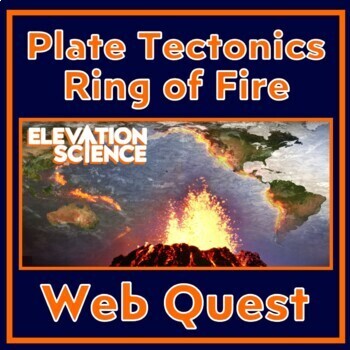Plate Tectonics Volcanoes In the Ring of Fire Activity Webquest
Elevation Science
639 Followers
Grade Levels
7th - 9th
Subjects
Resource Type
Standards
CCSSRST.6-8.4
CCSSRST.6-8.7
NGSSMS-ESS3-2
NGSSHS-ESS3-1
Formats Included
- PDF
- Google Apps™
- Webquests
Pages
3 pages
Elevation Science
639 Followers

Includes Google Apps™
The Teacher-Author indicated this resource includes assets from Google Workspace (e.g. docs, slides, etc.).
What educators are saying
I mainly used it as an "Aspire To" for students who had completed everything, so other students could catch up on assignments. But the kids that did it were interested in the volcanos, and it built upon the Plate Tectonics unit that they'd done in 6th grade.
Great resource! It was a good exercise in some geography skills as well as plate tectonics information. Took us about 45-60 minutes to complete in 7th grade.
Also included in
- SAVE $$$ with this bundle of 3 plate tectonics webquests! GOOGLE DOCS and PRINT VERSIONS INCLUDED!These plate tectonics worksheets provide a structured format for students to get the most out of 3 different interactive and reputable Earth Science websites. 3 PLATE TECTONICS WEBQUESTS:1. Plate TectPrice $8.60Original Price $10.75Save $2.15
Description
GOOGLE DOCS AND PRINT VERSION INCLUDED! In this FUN plate tectonics activity, students find REAL data about 3 volcanoes in the Ring of Fire.
The worksheet provides a structured format for students to get the most out of the Global Volcanism Program’s interactive, an up-to-date map of volcanoes throughout the world. Students are engaged because they choose the volcanos they research during the webquest.
This webquest covers the following:
- The relationship between tectonic plate boundaries and volcanoes
- Map reading and interpretation
- Using interactive websites while conducting research
- Becoming familiar with real volcanoes in the Ring of Fire
Teacher Notes:
- This resource is not editable.
- A link to the Google Docs version is provided in the downloadable PDF.
- Includes answer key.
- Get this resource at a discount in our Plate Tectonics WebQuest Bundle!
Please consider clicking HERE to follow Elevation Science on TPT!
Total Pages
3 pages
Answer Key
Included
Teaching Duration
N/A
Last updated Feb 28th, 2021
Report this resource to TPT
Reported resources will be reviewed by our team. Report this resource to let us know if this resource violates TPT’s content guidelines.
Standards
to see state-specific standards (only available in the US).
CCSSRST.6-8.4
Determine the meaning of symbols, key terms, and other domain-specific words and phrases as they are used in a specific scientific or technical context relevant to grades 6–8 texts and topics.
CCSSRST.6-8.7
Integrate quantitative or technical information expressed in words in a text with a version of that information expressed visually (e.g., in a flowchart, diagram, model, graph, or table).
NGSSMS-ESS3-2
Analyze and interpret data on natural hazards to forecast future catastrophic events and inform the development of technologies to mitigate their effects. Emphasis is on how some natural hazards, such as volcanic eruptions and severe weather, are preceded by phenomena that allow for reliable predictions, but others, such as earthquakes, occur suddenly and with no notice, and thus are not yet predictable. Examples of natural hazards can be taken from interior processes (such as earthquakes and volcanic eruptions), surface processes (such as mass wasting and tsunamis), or severe weather events (such as hurricanes, tornadoes, and floods). Examples of data can include the locations, magnitudes, and frequencies of the natural hazards. Examples of technologies can be global (such as satellite systems to monitor hurricanes or forest fires) or local (such as building basements in tornado-prone regions or reservoirs to mitigate droughts).
NGSSHS-ESS3-1
Construct an explanation based on evidence for how the availability of natural resources, occurrence of natural hazards, and changes in climate have influenced human activity. Examples of key natural resources include access to fresh water (such as rivers, lakes, and groundwater), regions of fertile soils such as river deltas, and high concentrations of minerals and fossil fuels. Examples of natural hazards can be from interior processes (such as volcanic eruptions and earthquakes), surface processes (such as tsunamis, mass wasting and soil erosion), and severe weather (such as hurricanes, floods, and droughts). Examples of the results of changes in climate that can affect populations or drive mass migrations include changes to sea level, regional patterns of temperature and precipitation, and the types of crops and livestock that can be raised.






